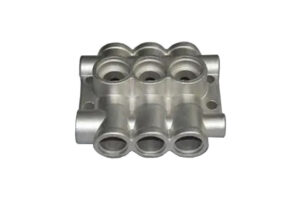Investment Casting Process: A Comprehensive Guide
 Investment casting, also known as lost-wax casting, is a manufacturing process that has been used for centuries to create intricate and complex metal parts. This process involves creating a wax pattern of the desired part, coating it with a ceramic shell, and then melting the wax out of the shell to create a cavity. Molten metal is then poured into the cavity, filling the space left by the wax pattern. Once the metal has solidified, the ceramic shell is broken away, revealing the finished part.
Investment casting, also known as lost-wax casting, is a manufacturing process that has been used for centuries to create intricate and complex metal parts. This process involves creating a wax pattern of the desired part, coating it with a ceramic shell, and then melting the wax out of the shell to create a cavity. Molten metal is then poured into the cavity, filling the space left by the wax pattern. Once the metal has solidified, the ceramic shell is broken away, revealing the finished part.
In this post, we will take a closer look at the investment casting process, its advantages and disadvantages, and the industries that use it.
The Investment Casting Process
The investment casting process begins with the creation of a wax pattern. This pattern is typically made using a mold or a 3D printer. The wax pattern is then coated with a ceramic slurry, which is allowed to dry. This process is repeated several times, building up a thick ceramic shell around the wax pattern.
Once the ceramic shell is dry, it is placed in a furnace and heated to a high temperature. This melts the wax out of the shell, leaving a cavity in the shape of the wax pattern. The ceramic shell is then filled with molten metal, which is allowed to cool and solidify.
After the metal has solidified, the ceramic shell is broken away, revealing the finished part. The part is then cleaned and finished, ready for use.
Advantages
Investment casting offers several advantages over other manufacturing processes. One of the biggest advantages is the ability to create complex and intricate parts with a high degree of accuracy. Investment casting can produce parts with very thin walls, sharp corners, and intricate details that would be difficult or impossible to create using other methods.
Another advantage of investment casting is the ability to use a wide range of materials. Investment casting can be used to create parts from a variety of metals, including steel, aluminum, bronze, and titanium. This makes it a versatile process that can be used in a wide range of industries.
Investment casting also offers excellent surface finish and dimensional accuracy. The ceramic shell used in the process creates a smooth surface finish that requires little or no additional finishing. The process also allows for tight tolerances, ensuring that the finished part meets the required specifications.
Disadvantages
While investment casting offers many advantages, it also has some disadvantages. One of the biggest disadvantages is the cost. Investment casting is a complex and time-consuming process that requires skilled labor and specialized equipment. This can make it more expensive than other manufacturing processes, especially for small production runs.
Another disadvantage of investment casting is the size limitations. Investment casting is best suited for small to medium-sized parts, typically weighing less than 50 pounds. Larger parts may require a different manufacturing process, such as sand casting or die casting.
Industries that Use Investment Casting
Investment casting is used in a wide range of industries, including aerospace, automotive, medical, and jewelry. In the aerospace industry, investment casting is used to create complex parts for aircraft engines and other critical components. In the automotive industry, investment casting is used to create parts for engines, transmissions, and suspension systems.
In the medical industry, investment casting is used to create implants and other medical devices. The ability to create complex and intricate parts with a high degree of accuracy makes investment casting an ideal process for creating medical devices that need to fit precisely and function reliably.
In the jewelry industry, investment casting is used to create intricate and detailed pieces of jewelry. The ability to create complex shapes and designs makes investment casting an ideal process for creating unique and one-of-a-kind pieces.
Conclusion
Investment casting is a versatile and reliable manufacturing process that offers many advantages over other methods. Its ability to create complex and intricate parts with a high degree of accuracy makes it an ideal process for a wide range of industries. While it does have some disadvantages, the benefits of investment casting make it a valuable tool for creating high-quality metal parts.






